We want to provide you with the correct “recipe”: a mix of art galleries such as Gamec and Accademia Carrara with historical museums, theaters and churches from every era. Then we add in artisan shops and fashion.
The dressing is the fascinating the medieval Upper Town and sprinkle thoroughly with the green of the Park of the Hills, the Botanical Garden and the furthest pre-Alps of Bergamo, the “Orobie”. Served to the table with accompanying dishes such as polenta or casoncelli and wash it all down with local wines such as Moscato di Scanzo or Valcalepio.
Losing yourself among all these courses can be charming, but if you prefer to have some advice on where to go and see, we created the right path for you. You will find the Bergamust, everything that you can not afford to miss in Bergamo.
Bon appetit!
We want to provide you with the correct “recipe”: a mix of art galleries such as Gamec and Accademia Carrara with historical museums, theaters and churches from every era. Then we add in artisan shops and fashion.
The dressing is the fascinating the medieval Upper Town and sprinkle thoroughly with the green of the Park of the Hills, the Botanical Garden and the furthest pre-Alps of Bergamo, the “Orobie”. Served to the table with accompanying dishes such as polenta or casoncelli and wash it all down with local wines such as Moscato di Scanzo or Valcalepio.
Losing yourself among all these courses can be charming, but if you prefer to have some advice on where to go and see, we created the right path for you. You will find the Bergamust, everything that you can not afford to miss in Bergamo.
Bon appetit!

Whether you come by train or bus, the first glance of the Upper Town from the station is priceless. Before you throw yourself on the “entree”, we want you to enjoy the fresh taste of the Piacentiniano Center (Lower Town), a coffee in the elegant bar of the Sentierone (Large Walking Path), the muscular architecture of Liberty Square or the sweet sounds of the Donizetti Theatre.
To help you start to get used to the complex taste of the art, it is definitely worth your time to take a visit to the churches of San Bartolomeo, Santo Spirito and San Bernardino (designed by Lorenzo Lotto).
Whether you come by train or bus, the first glance of the Upper Town from the station is priceless. Before you throw yourself on the “entree”, we want you to enjoy the fresh taste of the Piacentiniano Center (Lower Town), a coffee in the elegant bar of the Sentierone (Large Walking Path), the muscular architecture of Liberty Square or the sweet sounds of the Donizetti Theatre.
To help you start to get used to the complex taste of the art, it is definitely worth your time to take a visit to the churches of San Bartolomeo, Santo Spirito and San Bernardino (designed by Lorenzo Lotto).
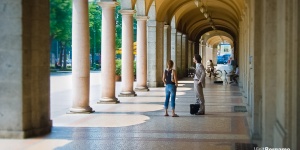
The centre of modern Bergamo is the ideal place to walk in the name of shopping, amusement, art and history!
This ancient and elegant part of the city is called Centro Piacentiniano, an amazing architectural complex that used to host the old city trade fair. This very same atmosphere still enlivens the area, thanks to the numerous markets and events filling the city centre with colours and scents all over the year. Walking along the Sentierone pedestrian way, passing by the imposing chestnut trees and beyond the Porta Nuova propylaea, you will get to via XX Settembre: here you can admire Palazzo Frizzoni, Bergamo’s City Hall.
From here on, enjoy the local life: boutiques, shops, alleys and beautiful small squares, in the name of amusement. Last but not least, how about a good coffee or a drink in one of the numerous cafes and bars?
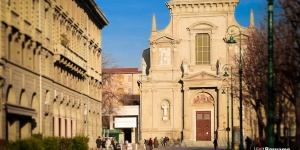
At the end of the eastern end of the Sentierone promenade, you can see the Church of Saints Bartolomeo and Stefano, built for the Dominican Religious Order in the first half of XVII Century, following the plan of the architect Antonio Maria Caneva.
Dominican order was not the first one to live in these places: in fact, the site used to belong to the community of the Order of the Humiliati. Formerly the complex used to consist of a church and some farmhouses.
If you observe the church from the outside you can notice the different construction periods: the façade, imitating a baroque style, was rebuilt in 897, the portico on the left was renovated in 1942, while the side overlooking via Tasso was made during the XIX Century.
The church features one aisle with five chapels on each side. The choir is decorated with beautiful XVI Century inlays, while behind the main altar you can admire the renowned Martinengo Altarpiece by Lorenzo Lotto, dating back to 1516.

Situated at the entrance of Bergamo’s most aristocratic road, this church was most likely built following the saint’s two visits to the city (1419-1422). Re-consecrated by the bishop in 1593, perhaps after a major restoration, it was decorated throughout the years.
Its neo-Gothic form was created between the nineteenth and twentieth century: a single space, punctuated by 5 bays, 3 of which are believed to be fifteenth-century, with a gabled facade. The altarpiece is the work of Lorenzo Lotto (1521) .
The church is managed by the Parish of Sant'Alessandro in Croce, and the visit is free thanks to the collaboration of the Touring Club Italiano volunteers.
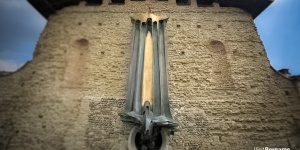
Walking along via Tasso, in the centre of Lower Bergamo, you will surely notice the rough façade of this church, overtopped by the imposing bronze statue of the Holy Ghost descending to the churchyard.
The previous building belonged to a XIV Century monastery. A group of rich merchants in the XVI Century decided to radically transform it in order to establish its social status by means of a church, besides the numerous palaces.
The church renovation took a long time. Over different periods, the two major architects from Bergamo worked on it: Pietro Isabello in the XVI Century and Gian Battista Caniana in the XVIII Century.
Five chapels per side flank the central nave. The fourth one on the right hosts the wonderful Altarpiece (oil on table) by the Italian Renaissance master Lorenzo Lotto, "Madonna and Child with Saint Catherine of Alexandria, St. Augustine, St. Sebastian and St. Anthony Abbot", 1521.
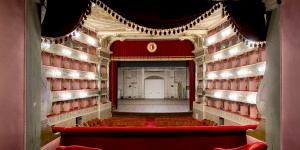
The Teatro Donizetti covers a total area of 3200 square meters. The hall’s dimensions respect the original 1786 design: it measures 360 square meters and it’s able to seat 532 people. There are 120 boxes, divided into three tiers, totalling 1154 seats.
It’s easy to understand how magnificent this building is and how astonished the Bergamo citizens were as they saw it, in an age when there only were small and temporary wooden theatres.
An enormous and sparkling chandelier, with 78 lamps, hangs from the middle of the ceiling, while other sources light up the stage.
Due to its sound harmony and distribution, the theatre is considered one of the best ones in Italy.
Originally named “Riccardi” after its maker, this Theatre is mostly renown as the place where Donizetti’s operas (more than 70!) were spread and appreciated by his fellow citizens.
Try to imagine the emotion experienced by Donizetti in theatre, when the audience assisting to the opera “L’esule di Roma – The exile from Rome”, gave a sincere and warm ovation. This happened in 1840: Donizetti would eventually die of disease in Bergamo a few years later, in his hometown, in 1848.

It's time to move on to more substantial “dishes”.
For the Adriano Bernareggi Muesuem we offer a rundown of sacred Bergamo art from all centuries to the present day.
If you are still not “full”, don’t be scared and throw yourself into the Carrara Academy: Its collection of paintings by Botticelli, Mantegna, Titian, Raphael, Dürer and many others, that will not leave you wanting more! Continue you on to take a tour of the halls of the Gallery of Modern and Contemporary Art (GAMeC), which will give and let you enjoy new and extraordinary tastes, just as tantalizing.
Not only art will feed a man: for lunch on Via San Tomaso or Santa Caterina will find classic and picturesque places to fill you up; once your refreshed you can then tackle the climb to the Upper Town.
It's time to move on to more substantial “dishes”.
For the Adriano Bernareggi Muesuem we offer a rundown of sacred Bergamo art from all centuries to the present day.
If you are still not “full”, don’t be scared and throw yourself into the Carrara Academy: Its collection of paintings by Botticelli, Mantegna, Titian, Raphael, Dürer and many others, that will not leave you wanting more! Continue you on to take a tour of the halls of the Gallery of Modern and Contemporary Art (GAMeC), which will give and let you enjoy new and extraordinary tastes, just as tantalizing.
Not only art will feed a man: for lunch on Via San Tomaso or Santa Caterina will find classic and picturesque places to fill you up; once your refreshed you can then tackle the climb to the Upper Town.
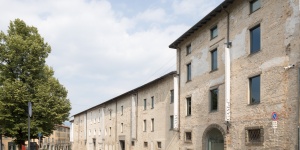
The Gallery of Modern and Contemporary Art was founded in 1991 right in front of the Accademia Carrara Picture Gallery, in a restored fifteenth-century architectural complex, formerly intended as a monastery. The diversified programming - open to experimentation with contemporary languages and to multidisciplinarity, and at the same time anchored to the roots of the institution and its heritage - has made it into a multifaceted space that has been able to involve different audiences over the years. With its 1500 square metres of exhibition space, it is a place that welcomes contemporary art in all its forms: temporary personal and collective exhibitions by international artists, new and emerging projects and a rich calendar of collateral activities designed for different audiences are the strong point of the Gallery’s cultural policy, which is a dynamic place for comparison, analysis and cultural integration, in constant evolution.
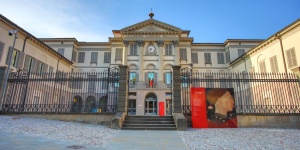
Museum
The Accademia Carrara in Bergamo is a museum with a specific and, in some ways, unique identity, closely tied to its origins and history. Unlike many Italian museums, Carrara is the result of the ambitious project of Giacomo Carrara (1714-1796) to promote the establishment of a cultural institution that would combine pleasure and education, serving as both an art gallery and a painting school. The success of this idea is evidenced by the extensive series of large and small donations made over more than two centuries by individuals and institutions. These, along with a few targeted acquisitions, have complemented the original foundation laid by the founder. Besides Carrara, leading the long list of donors are notable figures such as Guglielmo Lochis, Giovanni Morelli, Federico Zeri, and Mario Scaglia. Their collections form the backbone of the museum and contribute to defining the diverse and articulated character of its heritage.
The renewed visitor's journey is organized in 16 differently-sized rooms, showcasing a total of 350 exhibited works, including paintings, sculptures, medals, and plaques. Visitors thus have the opportunity to embark on a five-century journey through the history of Italian art, from the Renaissance to the nineteenth century, encountering masterpieces by Pisanello, Mantegna, Botticelli, Raphael, Titian, Lotto, Moroni, Hayez, and Pellizza da Volpedo.

Soon after the arch of St. Augustine, on the left, you will find its monastery and the park belonging to it.
Its benches are great for a digestive break, but if you already think your the active type, we recommend a visit to the gunboat of San Michele, and if the closed quarters aren’t for you than the former convent of St. Francis is more than a valid alternative.
And if even here the air and the view are not enough you can always climb the Gombito Tower.
Soon after the arch of St. Augustine, on the left, you will find its monastery and the park belonging to it.
Its benches are great for a digestive break, but if you already think your the active type, we recommend a visit to the gunboat of San Michele, and if the closed quarters aren’t for you than the former convent of St. Francis is more than a valid alternative.
And if even here the air and the view are not enough you can always climb the Gombito Tower.
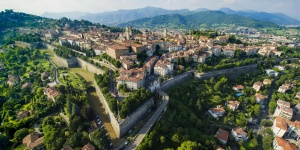
Bergamo wouldn’t be the same without its impressive Venetian Walls. This spectacular circuit is over six km long: it’s the perfect place to take a romantic walk and enjoy wonderful sunsets, and it has been enclosing the beauties of the Upper Town for more than four centuries.
The priceless artistic and cultural value of the Venetian Walls is demonstrated by their recognition as a Unesco World Heritage site.
They were built starting from 1561 by the Republic of Venice in order to face enemies attacks, but History was kind with them: maybe due to their stunning beauty, they never underwent any siege. That is why they remained almost intact to the present day.
The Walls consist of 14 bastions, 2 platforms, 100 embrasures for cannons, 2 armouries, four gates, not to mention the underground structures featuring sallies, passages and tunnels: don’t miss the chance to walk inside the Walls and to visit the casemates of San Michele and San Giovanni!
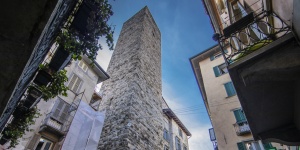
That’s an odd name, indeed! Do you know its origin? “Gombito” is the Italian evolution of the Latin word “compitum”.
However, there are several interpretations about the meaning of “compitum”. Some say it means “crossroad”, as the tower rises in the meeting point between the two main axis of the Roman town, the “decumanus” and the “cardo” (today’s via Gombito and via Lupo). Another argument claims that “compitum” means computare”, “counting”: in fact, the old numbering system of the streets started from here.
The imposing Gombito Tower was built in 1200 as a symbol of power and military hegemony during the struggles between the different city factions: it used to control the access to Piazza Vecchia, the core of Bergamo, from the roads coming from the valleys. Bergamo Administration owns it and opens it to the public in spring and summer: from its top you can enjoy a fantastic view of the surrounding territory!
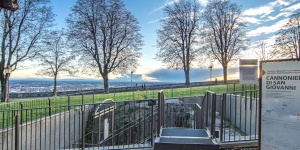
To enter the San Giovanni Casemate you have to go down a few meters under the ground by means of an iron staircase, in the rampart with the same name: this defensive structure was built right here, hundreds of years ago.
Getting to the manoeuvre area of the casemate, perfectly restored, history suddenly becomes something tangible, as you immediately understand what was war like five hundred years ago.
Casemates were used to allocate soldiers and cannons defending the city Walls. As you may notice, the embrasures don’t face the flatland: this is not a mistake, but a strategic choice! The cannons’ openings were guarded against the enemy fire, so that they could open fire to the enemy soldiers assaulting the walls.
Once you got back to surface, you will notice a particular metal object. It’s a sundial, a very ancient tool reinterpreted by using contemporary features and materials: it can almost seem an art installation, indeed!

Now you're close to the heart of Bergamo: the Old Square.
You can see the whole city from the top of the Bell Tower, or enjoy the majesty of the Colleoni Chapel. To better understand how they lived at the time of the Most Serene Republic of Venice, the interactive experience of the Museum of The Sixteenth Century is a must.
Lotto also makes his mark with his magnificent wooden tables inside the Santa Maria Maggiore, and if the appetite for churches still hasn’t left you, the Duomo awaits you next door.
Finally you just have to choose from one of the many places to dine in the romantic alleys of the medieval village or enjoy the view of the plains and the Apennines eating your last bite at San Vigilio.
Now you're close to the heart of Bergamo: the Old Square.
You can see the whole city from the top of the Bell Tower, or enjoy the majesty of the Colleoni Chapel. To better understand how they lived at the time of the Most Serene Republic of Venice, the interactive experience of the Museum of The Sixteenth Century is a must.
Lotto also makes his mark with his magnificent wooden tables inside the Santa Maria Maggiore, and if the appetite for churches still hasn’t left you, the Duomo awaits you next door.
Finally you just have to choose from one of the many places to dine in the romantic alleys of the medieval village or enjoy the view of the plains and the Apennines eating your last bite at San Vigilio.
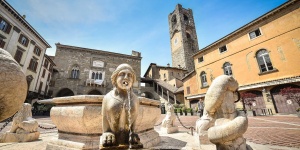
Piazza Vecchia represents the core of Città Alta: it has been the heart of political power for centuries and it keeps being one of the most popular places for Bergamo’s citizens to spend some time with friends.
Beauty is all around you if you have a seat at one of the square’s restaurants or cafes, having a drink, breakfast or even a romantic dinner. You can admire the building called “Palazzo della Ragione”, the oldest municipal seat in Lombardy, as well as the Torre Civica, a bell tower also called “Campanone”.
In the middle of the square is located the Contarini Fountain, which was donated to the city by the chief magistrate Alvise Contarini in 1780, while on the opposite side of Piazza Vecchia you can see the Palazzo Nuovo (“New Palace”), which served as Bergamo’s Town Hall until 1873 and is today the seat of the Angelo Mai Library. Its incredible collection includes ancient and precious books: incunabula, books from the 1500s, engravings, manuscripts and other inestimable artefacts making it one of the most outstanding libraries in Italy.
The geometrical layout of the buildings around the square is so harmonic that when Le Corbusier visited Bergamo he said “you can’t move a single stone, it would be a crime”
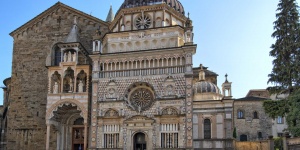
It’s surely the most beautiful building in Bergamo.
Its façade is decorated with red and white marble, an authentic Italian Renaissance masterpiece. The interiors are a fantastic collection of artworks: the equestrian statue of Bartolomeo Colleoni, mercenary captain from Bergamo, the marble sarcophaguses, the exquisite tomb of his daughter Medea, the inlayed wooden desks.
It would takes us pages and pages to describe them all, that’s why we suggest you to enter the chapel and let this art universe take you over!
Fun fact: legend has it that touching the coat of arms on the Chapel’s gate at midnight brings good luck. Believe it or not, it can be a nice excuse to take a walk to the lovely Città Alta by night!
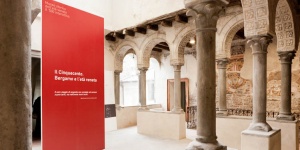
In the shadow of the Campanone (Civic Tower), the Palazzo del Podestà tells a story that has distant origins: on the ground floor, immerse yourself in Roman Bergamo with archaeological excavations, and then go up to the first floor and admire the wonderful frescoes of the Renaissance cavaedium.
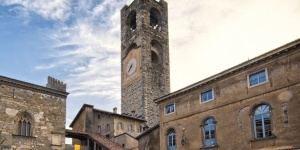
In the heart of Piazza Vecchia stands the Civic Tower, otherwise known as the Campanone, which with its height of 52.76 metres, offers a breathtaking panoramic view of the old town.